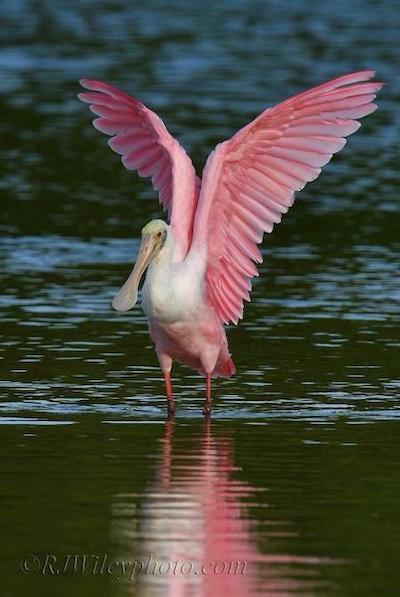
Roseate spoonbills and Wood storks/John Studwell
By Erika Zambello and Renee Wilson
Editor's note: This article is the third in a partnership series by Audubon Florida, connecting National Parks Traveler readers with avian stories from the Sunshine State's national park sites.
Roseate Spoonbills and Wood Storks are two of Florida’s most iconic birds. Unfortunately, 2020 has proved to be a poor nesting year for both species in South Florida, including populations within Everglades National Park. As critical ecosystem indicators, the success of both spoonbills and storks speaks directly to the health of the Everglades as a whole.
2018: A Banner Year
Just a few years ago, wading birds across South Florida had one of the best nesting seasons in decades. As National Parks Traveler reported, the second half of 2017 proved to be wet, increasing prey populations. In the spring of 2018, a drydown concentrated the prey in small polls and ponds, making easy pickings for adult birds feeding ravenous chicks. A wet summer and fall, a gradual dry-down period, and a drier spring, created right conditions for a proliferation of over 112,000 wading bird nests.

Roseate Spoonbill/RJ Wiley
2020: Not So Much
By contrast, rain came at inopportune times at the end of 2019 and into 2020.
Audubon Florida monitors water levels year-round as well as spoonbill breeding success each spring. In order for spoonbills to fledge their voracious young, water levels must fall far enough to trap prey in shallow water and/or small water bodies.
“Unfortunately, water levels in South Florida only decreased below the necessary threshold to concentrate these prey species items nine days in the 2019-2020 nesting season — bad news for the Roseate Spoonbill," Audubon Florida reports in the summer edition of Naturalist magazine.
Exactly how bad the news is will be known later this year when the nesting census is finalized.
Moving into the future, this may become the norm. Sea level rise has increased water levels overall, with 2019-2020 marking one of the most extreme years in Taylor Slough, where the measurements are taken.
According to Jerry Lorenz, Ph.D., Audubon’s Everglades Science Center Director, “When I started working on this project in the early 1990s, water levels remained below the stage where fish were concentrated for as long as four or five months, giving spoonbills plenty of time to raise their young and teach them to forage.”
Lorenz continues: “The good news is that spoonbills are finding new foraging grounds and being successful nesters elsewhere in the Everglades and throughout Florida. The bad news is that nest numbers continue to decline in Florida Bay, once the only nesting stronghold in the state.”
South Florida’s Wood Storks did not fare much better.
According to Shawn Clem, Ph.D., Director of Research at Audubon’s Corkscrew Swamp Sanctuary in the Western Everglades, this year’s Wood Stork nest failures were probably due to an unusual timing of rainfall in an ecosystem that is already stressed by development and habitat loss.
“Heavy rain in late December inundated wetlands early in the nesting season, delaying the birds’ reproduction and egg laying,” she said.

By March and April, water levels had dropped back down to favorable foraging conditions which triggered increased nesting, but this was too late. A late start to nesting often results in failure, as Wood Storks must have enough time to fledge their young during the dry season when fish prey are plentiful and can fill the chicks’ high energy demands. Once the rainy season begins, this year in mid-May, water levels rise quickly, fish disperse, and chicks that have not yet fledged are often left to starve as their parents can no longer catch enough fish to feed them.
Like spoonbills, Wood Stork populations are on the move. Wood Storks have demonstrated a shift in nesting locations over the past several decades, with more birds being reported in Georgia and farther north than ever before. According to Clem, while Wood Storks as a species may not be in jeopardy, their departure from historic nesting locations in Southwest Florida and across the Everglades is a strong indicator that the quality of the ecosystem has declined and these other places have become more favorable.
Erika Zambello, a Traveler board member, is the Audubon Florida communications director and Renee Wilson is the Audubon Florida communications associate. Some parts of this article have appeared in Audubon publications.





